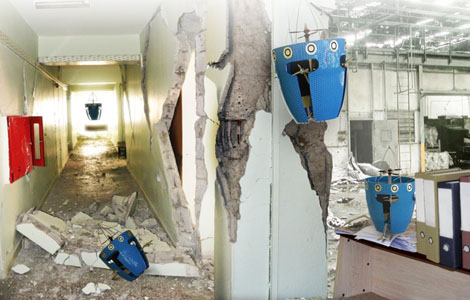Robot Fall, Robot Get Up
When the AirBurr flying robot crashes into an obstacle, it rights itself and keeps going

The AirBurr flying robot (artist's impression) can recover from collisions and resume exploring—without human intervention. Courtesy Adrien Briod, Adam Klaptocz, Jean-Christophe Zufferey, and Dario Floreano of the Laboratory of Intelligent Systems.
Is there anything robots can’t do? They operate on land, in the air, and at sea, and come in an astonishing range of shapes and sizes. Some weigh less than an insect, while others are large enough to carry several tons of bombs. For the military, they provide reconnaissance, defuse roadside bombs, and strike high-value targets. On the civilian side, a flying robot provided the first detailed video of the Fukushima Daiichi nuclear plant after it was damaged in the March 2011 earthquake and tsunami. Robots are helping The International Group for Historic Aircraft Recovery search for Amelia Earhart’s Lockheed Electra. And, as more than three million YouTube viewers have seen, they can even play the theme song from the James Bond franchise.
But one thing they do have difficulty with is recovering after collisions. That’s where AirBurr, a flying robot, has an advantage. Its flexible body protects the robot should it crash into a wall. And if it falls to the ground, AirBurr—using a leg design inspired by locusts and beetles—can right itself and continue flying. (During flight the robot’s four carbon-fiber legs are rolled up.)
“It all started when we looked at insects, and how they fly,” says researcher Adam Klaptocz, in EPFL’s video, below. “Even though they manage to avoid most obstacles, they still manage to fly into windows and fly into walls, yet it’s ok. They don’t break. They fall to the ground, they get back up again, and they keep flying.” The main application of this type of robot, says Klaptocz, is to explore hard-to-reach places where humans—or even other robots—can’t navigate, such as irradiated nuclear power plants, caves, and collapsed mines.
While some flying robots can try to avoid collisions by using on-board sensors that allow it to create a map of the environment, such platforms are heavier, fragile, and typically don’t survive any accidental crashes. The AirBurr team decided to create a robot that would withstand routine bumps and jolts. This approach allows them to use cheaper, less-complex sensors, and lightens the robot’s weight.
Learn more about AirBurr and the work of researchers Adrien Briod, Adam Klaptocz, Przemyslaw Mariusz Kornatowski, and Jean-Christophe Zufferey.